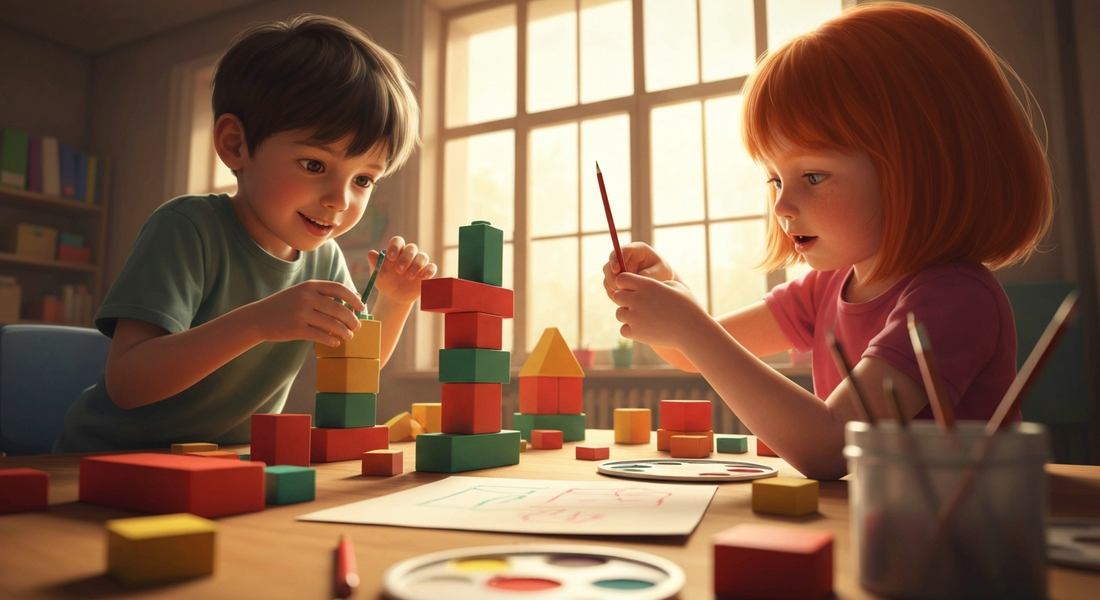Key Highlights
- Open-ended play is a vital type of play that is central to early childhood development.
- This play style directly boosts problem-solving skills by encouraging children to face challenges and create their own solutions.
- It is fundamental for building essential skills like creativity, critical thinking, and imagination.
- Open-ended play enhances social and communication skills as children learn to collaborate and negotiate.
- By creating a supportive environment, you can foster a love of learning and self-expression.
- It allows children to explore their world freely, without fixed rules or predetermined outcomes.
Introduction
Have you ever wondered how to raise a great problem solver? The secret might be simpler than you think. It lies in open-ended play, a powerful type of play that is a cornerstone of early childhood development. This is play without rules or a set outcome, where your child's imagination is the only guide. It’s a fantastic way to nurture essential skills, support emotional development, and help children build their understanding of the world, all while having fun.
Understanding Open-Ended Play and Its Impact on Childhood Problem Solving
At its core, open-ended play refers to activities without any fixed goals or predetermined scripts. Think of building a fort out of pillows or pretending to run a cafe. This kind of play is essential because it empowers children to make their own decisions and follow their curiosity wherever it leads.
This freedom is precisely what builds strong problem-solving skills. Unlike structured play with clear instructions, open-ended play encourages kids to think on their feet, adapt, and improve their communication skills. By providing a supportive environment for this play, you lay the foundation for lifelong learning. Let's look closer at how this works.
Defining Open-Ended Play: How It Differs from Structured Activities
This unique type of play is all about freedom. It's unstructured, imaginative, and completely self-directed. When your child engages in this kind of play, there are no right or wrong answers, no expectations, and no pressure to achieve a specific outcome. They are the boss of their own adventure, free to explore and create as they wish.
This is a stark contrast to structured activities or closed-ended toys, which have a specific goal. A puzzle, for instance, has only one correct solution. Open-ended play, however, allows children to take on different roles, whether they're a superhero, a chef, or an explorer.
This process allows them to make their own decisions and navigate challenges independently. It gives them the space to engage their imagination fully, helping them build a richer understanding of the world and their place within it.
The Connection Between Open-Ended Play and Developing Problem-Solving Skills
So, how does playing without rules lead to better problem-solving skills? When children are in charge of their own play, they naturally encounter various challenges and obstacles. A block tower might fall, or a fort might need a stronger wall. These moments are valuable learning opportunities.
Instead of following instructions, your child has to engage in critical thinking to find a solution. They are encouraged to experiment with new ideas and adapt their approach until they succeed. This builds resilience and teaches them to overcome obstacles in other areas of life.
Within a supportive environment, this process helps develop key abilities:
- It strengthens their ability to think critically and come up with their own solutions.
- It builds resilience by teaching them to try again after a setback.
- It boosts communication skills as they negotiate and collaborate with others.
- It promotes adaptability as they adjust to changing scenarios in their play.
Key Benefits of Open-Ended Play for Cognitive Development
The advantages of open-ended play extend far beyond a single skill. This form of play is a powerhouse for overall cognitive development, stimulating mental abilities like memory, attention, and logical thinking. As children engage in sensory exploration and experiment with cause and effect, they build a foundational understanding of the world around them.
Beyond the cognitive, this play is also crucial for emotional development, sparking creativity, and improving communication skills. It’s a holistic approach that touches every aspect of early childhood development. Let’s explore some of these key benefits in more detail.
Fostering Creativity, Critical Thinking, and Flexible Thinking
Creativity is at the heart of open-ended play. Without predetermined rules, children are free to think outside the box, create their own stories, and design imaginary worlds. Whether they are building a rocket ship to the moon or pretending to be a veterinarian, their imagination soars.
This imaginative process naturally leads to critical thinking. As children invent scenarios, they face self-made challenges that require them to think through potential solutions, directly improving their problem-solving skills. They learn to analyze situations and make decisions independently.
Ultimately, this fosters flexible thinking, which is a vital life skill. Open-ended play encourages children to:
- Explore new ideas without a fear of being wrong.
- Adapt their plans when things don't go as expected.
- View challenges from multiple perspectives.
- Create their own narratives and solutions.
The Role of Open-Ended Play in Academic Preparation and School Readiness
It may seem like just fun and games, but open-ended play is a critical component of school readiness. The skills developed during this unstructured playtime lay a strong foundation for future academic success.
When children make their own decisions during play, they learn autonomy and self-confidence. When they negotiate roles with friends, they practice their communication skills. These essential skills are exactly what they need to thrive in a classroom environment, from working on group projects to managing their own tasks.
Here’s how play-based skills translate to the classroom:
|
Skill Developed in Play |
Application in School |
|---|---|
|
Problem-Solving |
Thinking through math problems and science experiments. |
|
Communication & Teamwork |
Collaborating on group projects and class discussions. |
|
Creativity |
Excelling in writing, art, and creative assignments. |
|
Independence & Confidence |
Managing homework and taking initiative in learning. |
Practical Ways to Inspire Open-Ended Play at Home
Now that you understand the powerful benefits, how can you bring more open-ended play into your home? Creating a supportive environment is easier than you might think. It’s less about buying expensive toys and more about providing simple materials that spark imagination.
The goal is to offer a safe environment where your child can explore freely. This kind of setting encourages physical development, promotes collaboration with others, and helps them practice all the essential skills we’ve discussed. Let’s look at some simple ways to get started.
Choosing Open-Ended Toys and Materials That Spark Problem-Solving
The best open-ended materials are often the most versatile. Think about items that can be used in countless ways, rather than toys with a single function. Cardboard boxes, fabrics, building blocks, and art supplies are perfect examples of items that can become anything your child imagines.
Combining different materials can further ignite creativity and problem-solving skills. For instance, building with blocks helps develop fine motor skills, while larger items like a play couch can be transformed into a fort, a car, or a cozy reading nook. The possibilities are truly endless and provide limitless combinations for imaginative scenarios.
Here are a few great open-ended materials to have on hand:
- Building blocks, magnetic tiles, or LEGO bricks.
- Play dough, washable paint, and craft supplies.
- "Loose parts" like buttons, shells, sticks, and fabric scraps.
- A versatile and durable play couch for building and active play.
Parental Strategies for Encouraging Independent and Collaborative Play
Your role in open-ended play is to be a facilitator, not a director. The key is to create a supportive environment where your child feels confident making their own decisions. This means resisting the urge to step in and show them the "right" way to play.
By stepping back, you encourage independence and self-reliance. When your child plays with others, this freedom also fosters important social skills. They learn collaboration, negotiation, and empathy as they build, create, and imagine together.
Consider these simple strategies to encourage more open-ended play:
- Provide a variety of materials and then observe from a distance.
- Ask open-ended questions like, “What are you creating?” instead of giving directions.
- Designate specific times for unstructured, child-led play.
- Encourage teamwork and sharing during playdates to build social skills.
Conclusion
In summary, open-ended play is a powerful tool for fostering problem-solving skills in children. It encourages creativity, critical thinking, and flexible reasoning, all of which are essential for navigating life’s challenges. By providing the right environment and resources, parents can inspire their children to engage in independent and collaborative play, enhancing their cognitive development and academic readiness. As you explore ways to incorporate more open-ended play into your child's routine, remember that the benefits extend far beyond just fun—they cultivate a mindset ready to tackle future challenges. Embrace the journey of discovery and watch your child thrive!
Frequently Asked Questions
Why do experts recommend open-ended play for unlocking a child’s potential?
Experts advocate for open-ended play because it empowers children to make their own decisions and explore new ideas without limitations. This freedom is vital for developing essential skills like creativity and problem-solving, which helps them build confidence, express themselves, and unlock their full potential.
How does open-ended play prepare children for future challenges?
This play prepares children for the future by nurturing critical thinking and adaptability in a supportive environment. It enhances their emotional development by teaching them to manage frustration and handle conflicts. This improves their communication skills and gives them a better understanding of the world, equipping them to face challenges confidently.
Are certain age groups in India more likely to benefit from open-ended play for problem-solving?
Open-ended play is beneficial for all children, but it's especially critical during early childhood development. For toddlers, simple activities like stacking blocks help develop coordination and gross motor skills. The nature of play evolves as they grow, continuously building problem-solving skills adapted to their developmental stage.

